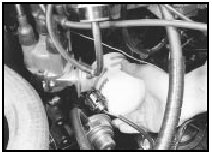Engine oil and filter renewal (Every 6000 miles (10 000 km) or 6 months)
1 Frequent oil and filter changes are the most important preventative maintenance procedures which can be undertaken by the DIY owner. As engine oil ages, it becomes diluted and contaminated, which leads to premature engine wear.
2 Before starting this procedure, gather together all the necessary tools and materials.
Also make sure that you have plenty of clean rags and newspapers handy, to mop up any spills. Ideally, the engine oil should be warm, as it will drain better, and more built-up sludge will be removed with it. Take care, however, not to touch the exhaust or any other hot parts of the engine when working under the vehicle. To avoid any possibility of scalding, and to protect yourself from possible skin irritants and other harmful contaminants in used engine oils, it is advisable to wear gloves when carrying out this work. Access to the underside of the vehicle will be greatly improved if it can be raised on a lift, driven onto ramps, or jacked up and supported on axle stands (see “Jacking and vehicle support”). Whichever method is chosen, make sure that the vehicle remains level, or if it is at an angle, so that the drain plug is at the lowest point (see illustration).

8.2 Sump drain plug location
3 Slacken the drain plug about half a turn.
Position the draining container under the drain plug, then remove the plug completely. If possible, try to keep the plug pressed into the sump while unscrewing it by hand the last couple of turns. As the plug releases from the threads, move it away sharply so the stream of oil issuing from the sump runs into the container, not up your sleeve! Recover the sealing washer from the drain plug.
4 Allow some time for the old oil to drain, noting that it may be necessary to reposition the container as the oil flow slows to a trickle.
5 After all the oil has drained, wipe off the drain plug with a clean rag. Check the sealing washer for condition, and renew it if necessary. Clean the area around the drain plug opening, and refit the plug. Tighten the plug to the specified torque.
6 Move the container into position under the oil filter.
7 Using an oil filter removal tool if necessary, slacken the filter initially, then unscrew it by hand the rest of the way (see illustration).

8.7 Unscrewing the oil filter
Empty the oil from the old filter into the container, and discard the filter.
8 Use a clean rag to remove all oil, dirt and sludge from the filter sealing area on the engine. Check the old filter to make sure that the rubber sealing ring hasn’t stuck to the engine. If it has, carefully remove it.
9 Apply a light coating of clean engine oil to the sealing ring on the new filter, then screw it into position on the engine. Tighten the filter firmly by hand only - do not use any tools.
Wipe clean the filter and sump drain plug.
10 Remove the old oil and all tools from under the car, then lower the car to the ground (if applicable).
11 Remove the oil filler cap and withdraw the dipstick. Fill the engine, using the correct grade and type of oil (see “Lubricants and fluids”). An oil can spout or funnel may help to reduce spillage. Pour in half the specified quantity of oil first, then wait a few minutes for the oil to fall to the sump. Continue adding oil a small quantity at a time until the level is up to the lower mark on the dipstick. Finally, bring the level up to the upper mark on the dipstick.
Insert the dipstick, and refit the filler cap.
12 Start the engine and run it for a few minutes; check for leaks around the oil filter seal and the sump drain plug. Note that there may be a delay of a few seconds before the oil pressure warning light goes out when the engine is first started, as the oil circulates through the engine oil galleries and the new oil filter, before the pressure builds up.
13 Switch off the engine, and wait a few minutes for the oil to settle in the sump once more. With the new oil circulated and the filter completely full, recheck the level on the dipstick, and add more oil as necessary.
14 Dispose of the used engine oil safely, with reference to “General repair procedures” in the Reference section of this manual.
See also:
Engine - removal leaving manual gearbox in vehicle
Note: The air conditioning system should
always be discharged by a Ford dealer or air
conditioning specialist.
Note: Refer to the warning in Section 8 before
proceeding. A suitable hoist and lifti ...
Temperature gauge sender removal and refitting
Removal
1 On SOHC models, the temperature gauge
sender is located on the front left-hand side of
the cylinder head, just in front of the inlet
manifold. On CVH models, the sender is
located on th ...
Centre console - removal and refitting
Removal
1 Remove the gear lever knob.
2 Pull the rubber gaiter up the lever and
remove it.
3 Undo the four screws and remove the
console (see illustrations).
30.3a Centre console lower retaini ...
